STO
Vulcans
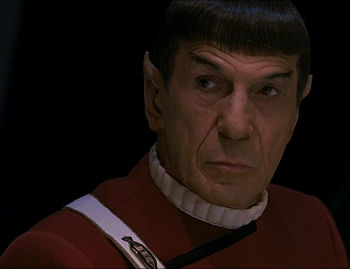
Spock, Vulcan male (ST-06)
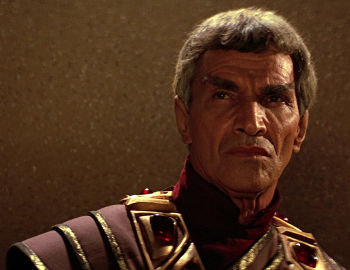
Sarek, Vulcan male (ST-03)

T’Pol, Vulcan female (ENT-22)
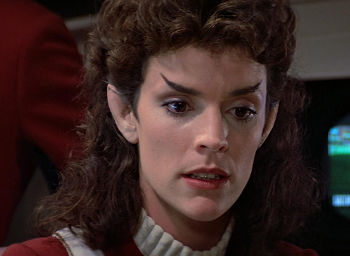
Saavik, Vulcan female (ST-03)
Species originating on Vulcan,[3] Vulcans were dedicated to a philosophy of emotional suppression in favor of total logic.[2]
References
- 1. “The Cage.” Star Trek, Episode 00. Television. 1965 (Unaired).
- 2. “Mudd’s Women.” Star Trek, Episode 03. Television. 13 October 1966.
- 3. “Amok Time.” Star Trek, Episode 34. Television. 15 September 1967.
- 4. “Journey to Babel.” Star Trek, Episode 44. Television. 17 November 1967.
- 5. “The Savage Curtain.” Star Trek, Episode 77. Television. 7 March 1969.
- 6. Star Trek II: The Wrath of Khan. Film. 4 June 1982.
- 7. “Broken Bow.” Star Trek: Enterprise, Episodes 01-02. Television. 26 September 2001.
Starbases

Watchtower-class starbase (TOS-53)
The Federation asserted its sovereignty in space space through a series of starbases, which could be located on a planet’s surface or on a space station, or a combination of both. This network of starbases provided a wide range of services; starbases could act as supply posts, recreation facilities, scientific outposts, trade hubs, and administrative centers. While all starbases provided each of these services, many were noted for their superiority in one or two specific areas.[1]
Starbases
| Number | Type | Location | Quadrant |
|---|---|---|---|
| 1 | Surface | Berengaria VII | Alpha |
| 2 | Station | Between Beta Auriga, Camus II; Near Betreka Nebula, Planet Q | Alpha |
| 4 | Station | Lyris Corridor | Unk. |
| 6 | Station | Past Aldebaran | Unk. |
| 7 | Station | Unk. | Unk. |
| 8 | Station | Near Pollux II | Unk. |
| 9 | K-series station | Near Pyris VII | Unk. |
| 10 | Station | Near Gamma Hydra IV; near Bassen Rift, Romulan Neutral Zone | Beta |
| 11 | Surface | Planet Yko | Alpha |
| 12 | Station | Gamma 400 System, near Deneva | Beta |
| 13 | Station | Pharos | Unk. |
| 14 | K-series station | Unk. | Unk. |
| 20 | Unk. | Unk. | Unk. |
| 23 | Unk. | Onias Sector, near Triangle border | Beta |
| 24 | R-1 class station | Klingon border; near Khitomer, Hromi Cluster | Beta |
| 27 | Surface | Near Klingon border | Beta |
| 29 | Unk. | Unk. | Unk. |
| 36 | Unk. | Along Klingon border; near Krios, Ty’gokor | Beta |
| 39-Sierra | Station | Along Romulan border; Kaleb sector | Beta |
| 40 | Unk. | Unk. | Unk. |
| 41 | Unk. | Unk. | Unk. |
| 44 | Station | Near Mariotian Sector | Unk. |
| 45 | Unk. | Algol II | Unk. |
| 47 (a.k.a. “Vanguard”) | Watchtower class station | Taurus Reach | Beta |
| 56 | Unk. | Unk. | Unk. |
| 63 | Unk. | Unk. | Unk. |
| 67 | Unk. | Unk. | Unk. |
| 68 | Unk. | Unk. | Unk. |
| 73 | Unk. | Unk. | Unk. |
| 74 | Spacedock station | Tarsas III | Unk. |
| 82 | Unk. | Unk. | Unk. |
| 83 | Unk. | Unk. | Unk. |
| 84 | Spacedock station | Unk. | Unk. |
| 87 | Unk. | Near Boraal II | Unk. |
| 92 | Spacedock station | Unk. | Unk. |
| 97 | Surface | Unk. | Unk. |
| 99 | R-1 class & Spacedock stations | Unk. | Unk. |
| 103 | Unk. | Near Minos | Unk. |
| 105 | Unk. | Near Klingon Border | Beta |
| 108 | Unk. | Unk. | Unk. |
| 113 | Unk. | Unk. | Unk. |
| 117 | Unk. | Along Klingon border, near Krios | Beta |
| 118 | Unk. | Unk. | Unk. |
| 123 | Unk. | Near Klingon & Romulan borders; near Iconia, Iccobar | Beta |
| 124 | Unk. | Unk. | Unk. |
| 129 | Unk. | Near Alpha Majoris | Alpha |
| 133 | Spacedock station | Unk. | Unk. |
| 137 | Unk. | Unk. | Unk. |
| 152 | Unk. | Near Canopus System | Beta |
| 153 | Unk. | Unk. | Unk. |
| 157 | Unk. | Near Acamar System, Triangle border | Beta |
| 173 | R-1 class station | Sector 23, near Romulan border | Beta |
| 179 | Surface | Unk. | Unk. |
| 180 | Spacedock station | Near Tholian Assembly | Alpha |
| 185 | Unk. | Approx. 2 years, 7 months from System J-25 at warp 9 | Beta |
| 195 | Surface | Nilicia Sector | Unk. |
| 200 | Unk. | Unk. | Unk. |
| 201 | Unk. | Unk. | Unk. |
| 211 | Station | Near Sheva System, along Cardassian border; Dorvan Sector | Alpha |
| 212 | Unk. | Along Klingon border; near Relay Station 47, Veridian System | Beta |
| 214 | Unk. | Near Penthara IV | Alpha |
| 215 | Spacedock station | Unk. | Unk. |
| 218 | Unk. | Unk. | Unk. |
| 219 | Unk. | Unk. | Unk. |
| 220 | Unk. | Near Tyken’s Rift | Unk. |
| 227 | Unk. | Unk. | Unk. |
| 231 | Unk. | Unk. | Unk. |
| 234 | Surface | Triangle border | Beta |
| 247 | Unk. | Near Romulan Neutral Zone | Beta |
| 257 | Station | Bajor Sector | Alpha |
| 260 | Unk. | Near Mar Oscura Nebula | Unk. |
| 295 | Unk. | Unk. | Unk. |
| 301 | Unk. | Near Satarran space | Unk. |
| 310 | Unk. | Near Alpha Trianguli; Dorvan Sector | Alpha |
| 313 | Unk. | Near Guernica System | Unk. |
| 315 | Unk. | BeTau Sector | Alpha |
| 324 | Unk. | Unk. | Unk. |
| 328 | Unk. | Near Barson II | Unk. |
| 336 | Unk. | Unk. | Unk. |
| 343 | Unk. | Near Paulson Nebula, Triangle border | Beta |
| 375 | R-1 class station | Kalandra sector | Alpha |
| 401 | Unk. | Unk. | Unk. |
| 416 | Unk. | Near Ogus II | Unk. |
| 440 | Unk. | Unk. | Unk. |
| 495 | Unk. | Near Marijne VII | Unk. |
| 514 | Unk. | Near Izar | Alpha |
| 515 | Surface | Scylla Sector, near Epsilon IX Sector | Unk. |
| 621 | Unk. | Near Tzenkethi Coalition border | Alpha |
| 718 | Unk. | Near Romulan Border; Sector Z-6 | Beta |
| Farspace Starbase Earhart | Unk. | Unk. | Unk. |
| G-6 | Unk. | Near Betazed | Alpha |
| Lya III | Unk. | Near Angosia III | Unk. |
| Montgomery | Surface | Unk. | Unk. |
| Xendi Starbase 9 | Unk. | Unk. | Alpha |
References
- 1. “Core Game Book.” Star Trek Role Playing Game, Book 4500. Game. 1999. Last Unicorn Games.
Klingons
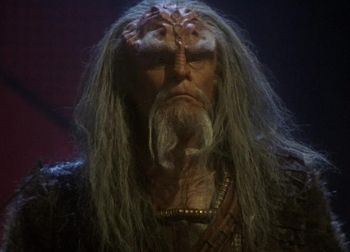
Chancellor Mirek (ENT-01-02)
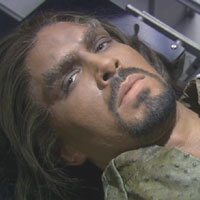
Marab (ENT-92)
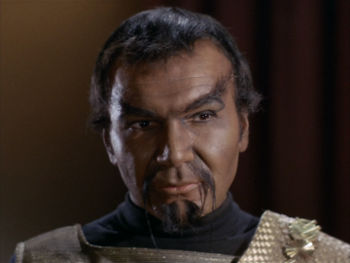
Kor (TOS-27)
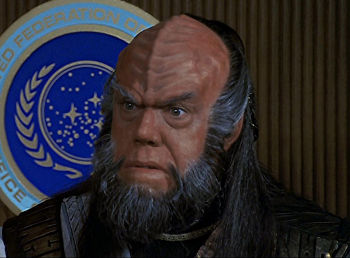
Klingon Ambassador (ST-06)
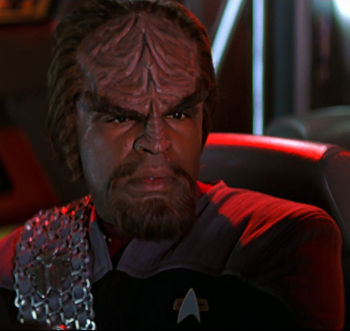
Worf (ST-09)
A humanoid, mammalian warrior society[1] from the planet Qo’noS (often transliterated as Kronos),[9] Klingons first encountered Humans in 2151, when a Klingon courier crash-landed on Earth.[20]
› Continue reading
Starfleet Academy
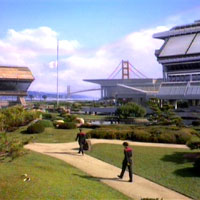
Starfleet Academy (TNG-219)

Starfleet Academy Seal (TNG-219)
An institute of higher learning and training facility for Starfleet officer candidates,[1] Starfleet Academy was founded in 2161 with the motto, “Ex astris, scientia,” a Latin phrase that translates as “From the stars, knowledge.”[3] Modeled after military academies from throughout Earth‘s history, the Academy, located at the Presidio[3] in San Francisco,[2] classified its cadets[3] — or midshipmen, in naval parlance[2] — with rankings based on class seniority.[2] Although admission to the Academy was open to non-Federation citizens, they required a letter of recommendation from a senior Starfleet officer, such as when Nog, a Ferengi, wished to apply in 2371.[4]
In 2368, when Captain Jean-Luc Picard of the U.S.S. Enterprise NCC-1701-D was asked to deliver the commencement address for the year’s graduating class, the occasion was marred by the loss of Cadet Joshua Albert in a training accident shortly before commencement was to occur.[3]
Starfleet Academy cadets in the 24th century were typically organized into squads of approximately a half-dozen cadets.[7] Although each squad was officially equal, the cadets in Red Squad were generally held to be the Academy’s elite students.[5] Members of Red Squad received their own dormitory, as well as other privileges, in addition to special training.[5] Because of this elite status, many cadets, including Nog[6] and his fellow Omega Squad cadet Matt Decker,[8] aspired to become part of Red Squad.
In 2372, however, Red Squad became an unwitting tool in Admiral Leyton‘s attempted coup of Earth’s government. Under orders from Leyton, Red Squad, commanded at the time by Cadet Riley Shepard, sabotaged Earth’s global power grid, which Leyton then blamed upon a Dominion attack.[5]
References
- 1. “Where No Man Has Gone Before.” Star Trek, Episode 01. Television. 22 September 1966.
- 2. Star Trek II: The Wrath of Khan. Film. 4 June 1982.
- 3. “The First Duty.” Star Trek: The Next Generation, Episode 219. Television. 30 March 1992.
- 4. “Heart of Stone.” Star Trek: Deep Space Nine, Episode 460. Television. 6 February 1995.
- 5. “Homefront.” Star Trek: Deep Space Nine, Episode 483. Television. 1 January 1996.
- 6. “Paradise Lost. Star Trek: Deep Space Nine, Episode 484. Television. 8 January 1996.
- 7. “Prime Directives.” Star Trek: Starfleet Academy, Issue 1. Comic Book. December 1996. Marvel Comics.
- 8. “Liberty.” Star Trek: Starfleet Academy, Issue 2. Comic Book. January 1997. Marvel Comics.
Starfleet Command

Starfleet Command (ST-04)
The operating authority for Starfleet,[1] Starfleet Command was based out of San Francisco on Earth,[2] though command facilities were also located on major worlds and starbases throughout Federation space.[3] The Chief of Starfleet Operations oversaw a staff of admirals, each responsible for a specific region or division.[4]
References
- 1. “Court Martial.” Star Trek, Episode 15. Television. 2 February 1967.
- 2. Star Trek IV: The Voyage Home. Film. 26 November 1986.
- 3. The Star Trek Encyclopedia. Book. 1997 (rev. ed.). Pocket Books.
- 4. “Core Game Book.” Star Trek: The Next Generation Role Playing Game, Book 25000. Game. August 1998. Last Unicorn Games.
Ships named Enterprise
There have been many ships named Enterprise.

Enterprise OV-101 (ST-07 Special Features)
Enterprise OV-101[4]
Space shuttle
The Enterprise OV-101 was the first Earth spacecraft to carry the name.
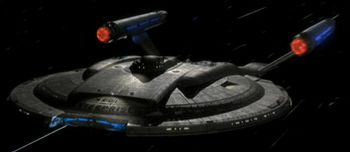
Enterprise NX-01 (ENT-01-02)
Enterprise NX-01 (E60)[14]
NX class
The Enterprise NX-01 (E60) was severely damaged during battle with the Xindi in 2153, limiting the ship to a maximum speed of Warp 1.7. Following the destruction of Earth in 2154, Xindi began to ruthlessly hunt down the remaining Humans. The Enterprise was one of only four Starfleet ships left, and escorted a group of some 6,000 survivors to settle on Ceti Alpha V. The Enterprise was destroyed in 2165, when the Xindi became aware of this final Human refuge.

Enterprise NX-01 (ENT-01-02)
Enterprise NX-01 (E73)[14]
NX class
The Enterprise NX-01 (E73) was from an alternate timeline in which the Enterprise NX-01 had been transported a century into the past; when it encountered its earlier incarnation in the Delphic Expanse, it was crewed by the ship’s descendants.
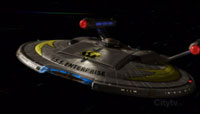
Enterprise NX-01 (Mirror) (ENT-94)
I.S.S. Enterprise NX-01 (Mirror)[15]
NX class
The I.S.S. Enterprise NX-01 was the counterpart of the Enterprise NX-01 from the Mirror Universe.
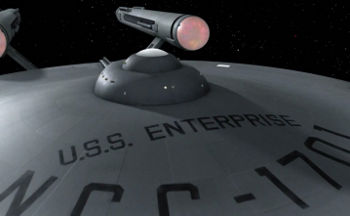
U.S.S. Enterprise NCC-1701 (TOS-61)
U.S.S. Enterprise NCC-1701[1]
Constitution class
The U.S.S. Enterprise NCC-1701 was the flagship of the Federation Starfleet.
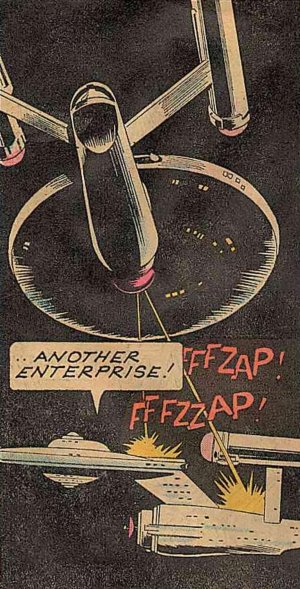
U.S.S. Enterprise NCC-1701 (TOS GK 33)
U.S.S. Enterprise NCC-1701 (Alt-GK33)[3]
Constitution class
The U.S.S. Enterprise NCC-1701 (Alt-GK33) was the U.S.S. Enterprise NCC-1701’s counterpart from the GK33 Timeline.
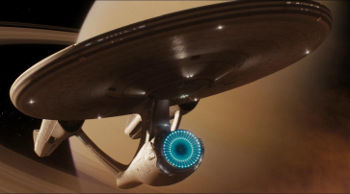
U.S.S. Enterprise NCC-1701 (ST-11)
U.S.S. Enterprise NCC-1701 (Alt-ST11)[16]
Constitution class (Alt-ST11)
The U.S.S. Enterprise NCC-1701 (Alt-ST11) was the U.S.S. Enterprise NCC-1701’s counterpart from the ST11 Timeline.

I.S.S. Enterprise (TOS-39)
I.S.S. Enterprise NCC-1701 (Mirror)[2]
Constitution class
The I.S.S. Enterprise NCC-1701 was the flagship of the Terran Empire Starfleet.
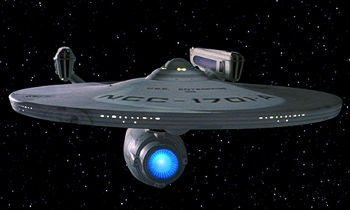
U.S.S. Enterprise NCC-1701-A (ST-06)
U.S.S. Enterprise NCC-1701-A[5]
Constitution class
The U.S.S. Enterprise NCC-1701-A was the flagship of the Federation Starfleet.

U.S.S. Enterprise NCC-1701-B (ST-07)
U.S.S. Enterprise NCC-1701-B[10]
Excelsior class
The U.S.S. Enterprise NCC-1701-B was the flagship of the Federation Starfleet.
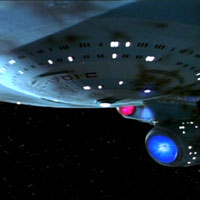
U.S.S. Enterprise NCC-1701-C (TNG-163)
U.S.S. Enterprise NCC-1701-C[7]
Ambassador class
The U.S.S. Enterprise NCC-1701-C was the flagship of the Federation Starfleet.
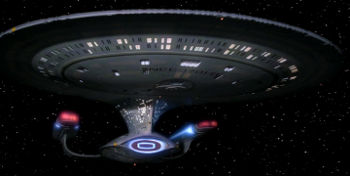
U.S.S. Enterprise NCC-1701-D (ST-07)
U.S.S. Enterprise NCC-1701-D[TNG-101]
Galaxy class
The U.S.S. Enterprise NCC-1701-D was the flagship of the Federation Starfleet.

Galaxy class (TNG-101-102)
I.S.S. Enterprise NCC-1701-D (Mirror)[8]
Galaxy class
The I.S.S. Enterprise NCC-1701-D was the flagship of the Terran Empire Starfleet.
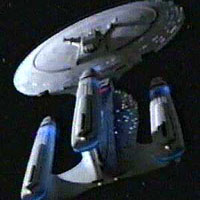
U.S.S. Enterprise NCC-1701-D Dreadnought (TNG-277-278)
U.S.S. Enterprise NCC-1701-D Dreadnought (Anti-time future)[8]
Galaxy class
The U.S.S. Enterprise NCC-1701-D was a dreadnought refit of the ship from a possible future timeline encountered in 2377 by Captain Jean-Luc Picard.

U.S.S. Enterprise NCC-1701-E (ST-08)
U.S.S. Enterprise NCC-1701-E[11]
Sovereign class
The U.S.S. Enterprise NCC-1701-E was the flagship of the Federation Starfleet.
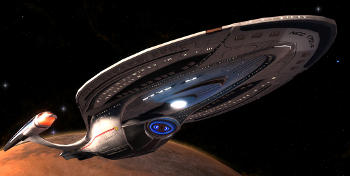
U.S.S. Enterprise NCC-1701-F (STO)
U.S.S. Enterprise NCC-1701-F[17]
Odyssey class
The U.S.S. Enterprise NCC-1701-F was the flagship of the Federation Starfleet.

U.S.S. Enterprise NCC-1701-J (ENT-70)
U.S.S. Enterprise NCC-1701-J[13]
Class Unknown
The U.S.S. Enterprise NCC-1701-J was from a possible future glimpsed by Captain Jonathan Archer of the Enterprise NX-01 in 2153.
References
- 1. “The Cage.” Star Trek, Episode 0. Television. 1965 (Unaired).
- 2. “Mirror, Mirror.” Star Trek, Episode 39. Television. 6 October 1967.
- 3. “The Choice.” Star Trek, Issue 33. Comic Book. September 1975. Gold Key.
- 4. Star Trek: The Motion Picture. Film. 7 December 1979.
- 5. Star Trek IV: The Voyage Home. Film. 26 November 1986.
- 6. “Encounter at Farpoint.” Star Trek: The Next Generation, Episodes 101-102. Television. 28 September 1987.
- 7. “Yesterday’s Enterprise.” Star Trek: The Next Generation, Episode 163. Television. 19 February 1990.
- 8. “Dark Mirror.” Star Trek: The Next Generation. Novel. December 1993. Pocket Books.
- 9. “All Good Things…” Star Trek: The Next Generation, Episodes 277-278. Television. 23 May 1994.
- 10. Star Trek: Generations. Film. 18 November 1994.
- 11. Star Trek: First Contact. Film. 22 November 1996.
- 12. “Broken Bow. Star Trek: Enterprise, Episodes 01-02. Television. 26 September 2001.
- 13. “Azati Prime”. Star Trek: Enterprise, Episode 70. Television. 3 March 2004.
- 14. “E2“. Star Trek: Enterprise, Episode 73. Television. 5 May 2004.
- 15. “In a Mirror, Darkly”. Star Trek: Enterprise, Episode 94. Television. 22 April 2005.
- 16. Star Trek. Film. 8 May 2009.
- 17. “Boldly They Rode.” Star Trek Online. Game. 10 March 2012.
Deep Space Station K-7
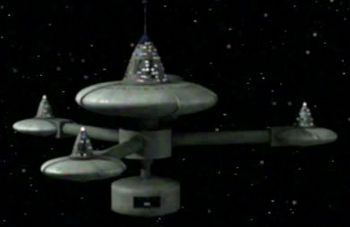
Deep Space Station K-7 (TOS-42)
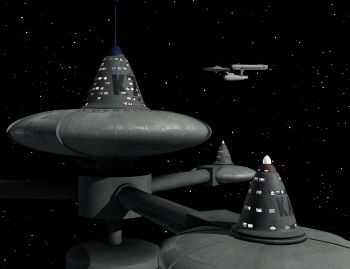
Deep Space Station K-7 (TOS-42)
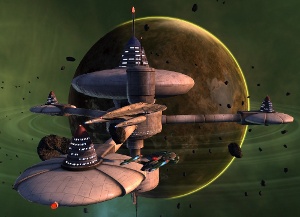
Deep Space Station K-7 (STO)
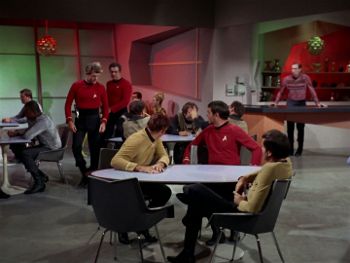
Bar on K-7 (TOS-42)
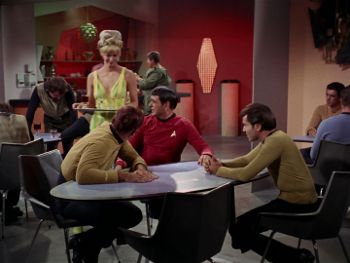
Bar on K-7 (TOS-42)
One of nine space stations strung along the Klingon frontier between 2218 and 2293, Deep Space Station K-7 began as a strategic outpost.[3] Located one parsec from the nearest Klingon outpost, and near the disputed colony world of Sherman’s Planet, K-7 was tasked to help ensure the development of the world would favor the Federation under the terms of the Organian Peace Treaty.[1] Most of K-7 consisted of storage areas and industrial fabrication facilities, and relatively little of the station was actually inhabitable.[2] By the terms of the Organian treaty, all frontier stations of both nations were open to each others’ traffic, which made K-7 a hub for spies and confrontation.[3] The Federation’s development project for Sherman’s Planet was threatened in 2266, when some 1,771,561 tribbles infested the storage bins of Quadrotriticale intended for the project, though this infestation ultimately helped uncover a Klingon sabotage attempt, as well as an undercover Klingon agent, disguised as a Human bureaucrat named Arne Darvin.[1] Unknown to anyone at the time, Darvin’s future self had traveled back in time from 2373 in an attempt to alter events and prevent his dishonor, but Starfleet personnel from his time prevented him from altering the timeline.[2] With the Khitomer Accords and the growing Federation-Klingon alliance, K-7 became a major transit point and meeting place for Federation and Klingon ships and personnel.[3]
STO Timeline
In 2409, K-7 remained in active service, although heavily upgraded over the decades, and found itself on the front lines of a renewed conflict between the Federation and the Klingon Empire. Commanded by Commander Naomi Wildman, K-7 was a focal point for Starfleet ships entering sectors under active dispute between the two powers.[4]
References
- 1. “The Trouble With Tribbles.” Star Trek, Episode 42. Television. 29 December 1967.
- 2. “Trials and Tribble-ations.” Star Trek: Deep Space Nine, Episode 503. Television. 4 November 1996.
- 3. “Starfleet Operations Manual.” Star Trek Roleplaying Game, Book 3. Game. 2003. Decipher, Inc.
- 4. “Voyage into Deep Space.” Star Trek Online. Game. February 2010. Cryptic Studios.
Miranda class
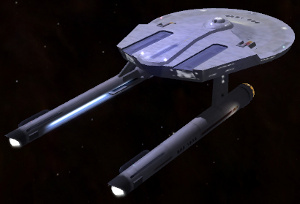
Miranda class (Legacy)
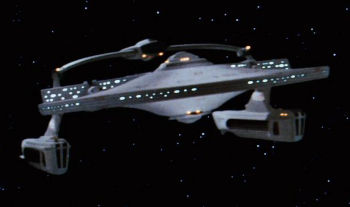
Miranda class (ST-02)
A Starfleet fixture of long-range scientific, supply, and exploratory missions for more than a century, Miranda class vessels probably logged more parsecs than any other single Federation vesel class. During the 23rd century, Starfleet Command placed an increasing emphasis on deep space exploration and surveying. The first ships launched after the inception of the exploratory vessel initiative, Miranda class vessels represent the most notable result of Starfleet’s renewed focus on exploration and discovery.[30] First commissioned during the period known as “The Great Awakening,” the Miranda class cruiser was in the forefront of that expansion effort. At the time, Starfleet itself was expanding in response to the changing and expanding economic and political goals of the Federation. To meet the demand of a larger navy, the Military Appropriations Committee authorized the development and testing of hundreds of vessel types, the Miranda among them.[6]
During this same period, the concepts of ship design were rapidly evolving and becoming more sophisticated, and the technology to build and operate starships was going through a revolution. Advances in all facets of the technology required to construct, maintain, and operate a starship were changing so rapidly that some ships were obsolete before they were completed. The Miranda design was changed no fewer than twelve times before the tooling and machining was begun. When these new cruisers were launched, they were only capable of performing three-year missions with resupply at one-year intervals. This made their dual-purpose role of research cruiser harder to perform. With the great distances that had to be travelled, they could not get more than six months travel time from a friendly outpost. This meant they could only advance as fast as the frontier was expanding. The class required some alterations during its trials and was to see many more changes after its commissioning, the last of which was a major refitting in the 2270s similar to that of the Constitution class.[6] Merging a host of diverse capabilities, versatility quickly became a hallmark of the class. Although Miranda class ships would primarily undertake scientific and exploratory missions, certain systems modules were swappable. These Miranda variants enjoyed great popularity in the early 24th century, and their expanded tactical and defensive systems were more than a match for most foes. Ships of this class participated in every major battle of the 24th century, often serving on the secondary or reserve battle lines.[30]
By the middle of the 24th century, Starfleet recommissioned many Miranda class vessels and sent them to surplus depots, scrapped them for parts, or used them as training vessels. Federation member planets and allied systems such as Altair and Betelgeuse first began to add reconditioned Miranda class ships to their own space fleets by the 2360s, after the active production life of these ships ceased. Hence, many Miranda class vessels continued to serve with distinction throughout Federation space and beyond for decades after their theoretical obsolescence.[30]
› Continue reading
Excelsior class
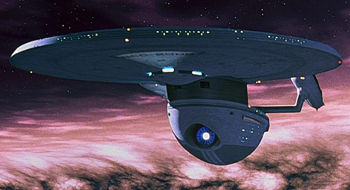
Excelsior class (ST-06)
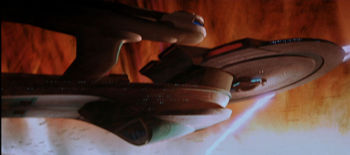
Excelsior class refit (ST-07)
In October 2284, the U.S.S. Excelsior NX-2000, the first of a new class, was commissioned. This vessel was the newest in Starfleet, and it incorporated many experimental operating systems.[3] Originally designed as a test-bed for the experimental transwarp drive, the Excelsior was called “The Great Experiment” by many in influential circles.[1] These ships were the newest of any in Starfleet and incorporated experimental technology in most of the components required to operate a starship. With so many new systems aboard these vessels, the process of testing them was slow. Prior to being installed, each component was tested and retested until it met standards. Nevertheless, when the Excelsior was taken out for trials, the evaluation teams were constantly faced with primary system malfunctions that would not allow any of the secondary or backup systems to be tested. This caused the evaluators to deal with these new components on a one-at-a-time basis, and thus creating time delays in the commissioning of the class.[3]
The Excelsior class underwent a number of late design changes when the transwarp project ultimately failed. While transwarp was never realized, designers were unwilling to cast aside what was otherwise a sound cruiser design. The transwarp engines were removed in favor of conventional linear warp drive engines. The Excelsior class could cruise at Warp 8, sustain speeds of Warp 10 for several hours, and reach Warp 13 when necessary. This made it by far the fastest Starfleet vessel for almost five decades.[31]
› Continue reading
Constellation class
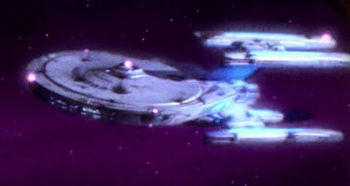
Constellation class (TNG-110)
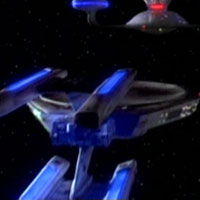
Constellation class (TNG-147)
The Constellation class was a starship type with four warp nacelles,[1] first commissioned in 2276.[11] The warp nacelles and several components of the saucer section shared many design similarities with the Constitution and Miranda class designs of the era.[1] Constellation-class ships were on the verge of being phased out in the mid-2360s,[6] but some were still in service in in 2370.[9] Several had already been decommissioned by 2365, including the U.S.S. Hathaway NCC-2593, which had been stripped of its offensive systems and rendered “warp inactive” by removing all antimatter from its warp reaction system.[6]
› Continue reading
Categories
- Animated Series (60)
- Articles (28)
- Books (447)
- Cast & Crew (79)
- Comics (22)
- DS9 (328)
- Early Voyages (125)
- Education (5)
- Enterprise (373)
- Excelsior (36)
- Food (19)
- Games (223)
- Klingon (70)
- Library (1,543)
- Logs (593)
- Lost Era (55)
- Medicine (18)
- Merrimac (1)
- Mirror (35)
- Miscellaneous (13)
- New Frontier (54)
- Next Generation (635)
- Original Series (681)
- Personnel (436)
- Places (369)
- Politics (12)
- Recreation (10)
- SCE (41)
- Science (1)
- Shatnerverse (9)
- Ships (455)
- Site Updates (98)
- Starfleet Academy (86)
- Stargazer (42)
- STO (61)
- Technology (45)
- Titan (59)
- To Boldly Go (1)
- TV/Film (214)
- Uncategorized (4)
- Vanguard (76)
- Voyager (236)
- Weapons (27)
- Xenology (54)
